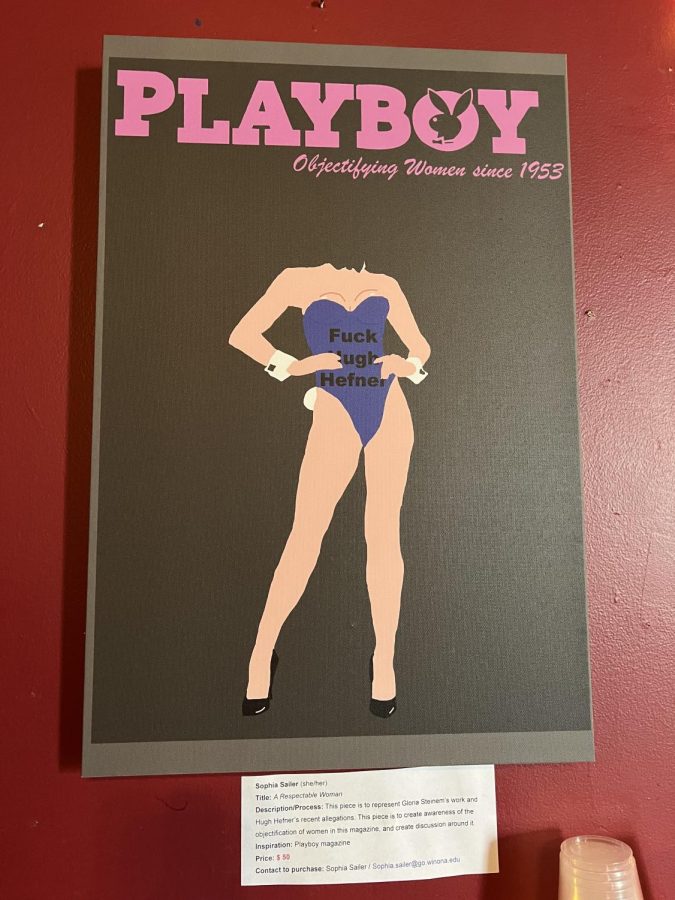
Olivia Volkman-Johnson / Winonan
Optical illusions make viewers believe they are seeing an image as one thing, then challenge them to see it in another way. Similarly, professor Chun Lok Mah said he wants his newest art pieces to challenge viewers to see their cultural beliefs in a different way.
The “WE”nona Project, an art installation created by Mah, debuted in the Paul Watkins Gallery in Watkins Hall on the Winona State University campus Wednesday, March 15.
The gallery will be open to the public until Friday, Apr. 7 after an artist reception Wednesday, Apr. 5.
Mah, a professor of art and design at the university, started the project during his sabbatical in the 2013-2014 school year. Mah not have a clear idea of the project until more recently.
“Initially, I have a concept for my sabbatical shows,” Mah said. “The show has continued to change and evolve, especially this particularly show that is motivated by recent events.”
The project, as described in the gallery, is meant to “initiate an inclusive dialogue on creating a safe, vibrant and supportive community.”
Mah explained one of the barriers of this dialogue is the practice of being “Minnesota nice”—the avoidance of conflict in favor of being polite towards one another.
Each piece in the installation corresponds to a different message, which promotes inclusivity and invites spectators to interact.
“This is a project. This is not an art show, which means that you’re supposed to see how it evolves,” Mah said.
Mah said each piece in the gallery is meant to make spectators think about two opposing ideologies by utilizing optical illusions.
One piece in the installation consists of numerous multicolored, paper dots on the floor against adjacent walls of the gallery. Each dot has an outer ring that changes color as you move towards the back wall of the gallery.
Mah explained though the colors of the outer ring gradually turn from blue to green and from orange to pink, the colors in the middle of the dots stay the same.
“You can see the subtle hint of the division of two sides. It’s implying a political choice, but ultimately there’s no pure blue and there’s no pure red,” Mah said. “It’s just an illusion. All of us are influenced by our surroundings [and] the way we think.”
Mah also encouraged spectators to pick up a dot and answer the question on the back, then stick the now white dot onto the black wall in the back of the gallery.
“When the dot is on the floor, there is a separation. As the dot is being taken and put on the wall, the separation becomes a white dot,” Mah said.
Another part of the installation includes 14 pieces on the walls of the gallery feature two or more words that can only be seen by standing far away, nearby, or through iPhone camera filters.
Mah said the core part of the project is a piece that shows the words ‘inspire’ and ‘aspire,’ which symbolizes both his aspiration to create the “WE”nona project, as well as to inspire those who experience it.
“It makes a huge difference when you aspire to do something, but no one wants to participate… you want to aspire from afar, but you want to inspire people too,” Mah said.
Some of the other pieces highlighted contrasts between pity and empathy, science and belief and fear and respect.
Though the project is held on campus, Mah said he wants the project to be viewed by all Winona citizens.
“‘WE’nona is a project focused on the local people… it’s about this town and about the people here and about my life here,” Mah said.
Mah, who immigrated from Malaysia 20 years ago, said the project is heavily influenced by his experiences living in Winona and hopes to educate others on how to be “more open to accepting different ideology and not always be afraid of change.”
“America is a country for me that is such a vibrant, diverse community, and that’s what makes it so creative and so different from any other country,” Mah said. “It seems like people forget about that and [about] what is considered ‘American’ and I just felt sad to see that going away. I want to make sure that people know it.”
By Olivia Volkman-Johnson





























































